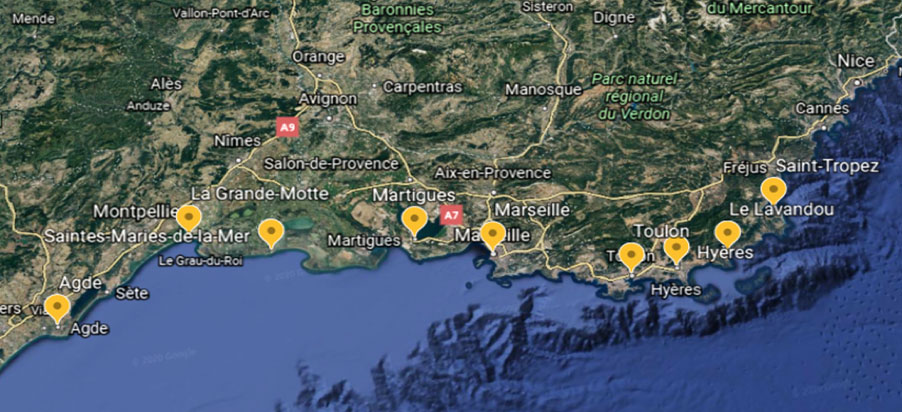Italian Riviera & Amalfi Coast
Arrive at Naples airport and transfer by taxi to the quay where your experience is ready to commence.
PreviousNext
Day 1 and 2 – Naples
Ah! Napoli. “See Naples and die”. A saying of unknown origin.
This city in southern Italy, sits on the Bay of Naples. Nearby is Mount Vesuvius, the still-active volcano that destroyed nearby Roman town Pompeii. Dating to the 2nd millennium B.C., Naples has centuries of important art and architecture. The city’s cathedral, the Duomo di San Gennaro, is filled with frescoes. Other major landmarks include the lavish Royal Palace and Castel Nuovo, a 13th-century castle.
Day 3 – Ischia
20 Nm to the island of Ischia. Ischia is a volcanic island in the Gulf of Naples, Italy. It’s known for its mineral-rich thermal waters. Hot springs bubble up at Maronti Beach, in the south. East, Roman remains lie beneath the sea floor at Cartaromana Beach. The beach has views of medieval Aragonese Castle, linked to Ischia by a stone bridge. Nearby, 18th-century Palazzo dell’Orologio houses the Sea Museum, devoted to Ischia’s fishing tradition.
Day 4 – Ventotene
22Nm to Ventotene which is one of the Pontine Islands in the Tyrrhenian Sea, 46 kilometres off the coast of Gaeta right at the border between Lazio and Campania, Italy. The municipality of Ventotene, of the province of Latina had 708 permanent residents as of 2008
Day 5 – the Blue Grotto on AnaCapri
38Nm of wonderful blue water sailing passing Ischia going South East to the Blue Grotto. The Blue Grotto is a sea cave on the coast of the island of Capri, southern Italy. Sunlight passing through an underwater cavity and shining through the seawater creates a blue reflection that illuminates the cavern. Overnight in a nearby cove of Cala del Rio, wind permitting.
Day 6 – Pompeii
15Nm to Pompeii a city in southern Italy’s Campania region overlooked by the active volcano at Vesuvius. It’s known for its ancient city, Pompeii, which was buried by the 79 A.D. eruption of Mount Vesuvius. Ruins here include the frescoed Villa of the Mysteries and the city’s amphitheatre. In town, the Catholic pilgrimage site of the Sanctuary of the Madonna of the Rosary has mosaics and a grand cupola .
Day 7 – Sorrento
Only just over an hour and 8 Nm to Sorrento, facing the Bay of Naples on the Sorrentine Peninsula. Perched atop cliffs that separate the town from its busy marinas, it’s known for sweeping water views and Piazza Tasso, a cafe-lined square. The historic centre is a warren of narrow alleys that’s home to the Chiesa di San Francesco, a 14th-century church with a tranquil cloister.
Day 8 – Capri
10Nm to Capri, an island in Italy’s Bay of Naples, is famed for its rugged landscape, upscale hotels and shopping, from designer fashions to limoncello and handmade leather sandals. In summer, Capri’s dramatic, cove-studded coastline draws many yachts.
Day 9 – Amalfi
22 Nm to Amalfi. Views of the majestic Amalfi Coast. A town in a dramatic natural setting below steep cliffs on Italy’s southwest coast. Between the 9th and 11th centuries, it was the seat of a powerful maritime republic. The Arab-Norman Sant’Andrea cathedral at the heart of town, with its striped Byzantine facade, survives from this era. The Museo Arsenale Amalfi is a medieval shipyard-turned-exhibition space.
Day 10 – Salerno
10 Nm to Salerno. A port city southeast of Naples, in Italy. Atop Monte Bonadies, the centuries-old Arechi Castle has sea views, plus Museo Medievale del Castello, exhibiting medieval ceramics and coins. In town, built on the ruins of a Roman temple, is Salerno Cathedral. It has Byzantine bronze doors, a baroque crypt and a marble altar. The terraced Minerva’s Garden has been growing medicinal plants since the 14th century.
Take the return flight home from Salerno

